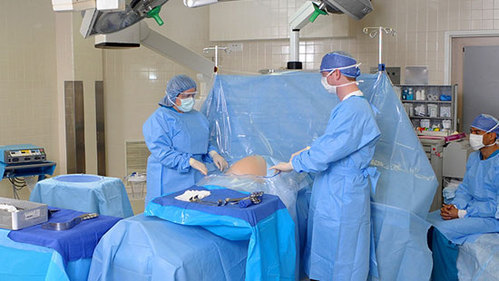a. The procedure of covering a patient and surrounding areas with a sterile barrier to create and maintain a sterile field during a surgical procedure is called draping.
The purpose of draping is to eliminate the passage of microorganisms between nonsterile and sterile areas. Draping materials may be disposable or nondisposable. Disposable drapes are generally paper or plastic or a combination and may or may not be absorbent. Nondisposable drapes are usually double-thickness muslin. Drapes, of course, must be sterile.Show Less
b. Since draping is very important in preparing a patient for surgery, it must be done correctly. The entire surgical team should be familiar with the draping procedure. The scrub must know the procedure perfectly and be ready to assist with it. During the draping procedure, the circulator should stand by to direct the scrub as necessary and to watch carefully for breaks in sterile technique.
(1) The first step in draping is the placing of a drape sheet from the foot to the knees. The scrub will select the sheet and hand one end to the surgeon across the operating table, supporting the folds, keeping it high, and holding it taut until it is opened, then drop it (open fingers and release sheet).
The second drape sheet is handled in the same manner. This sheet is placed below the incision site with the edge of the sheet just below the incision site. This draping sheet provides extra thickness of material under the area from the Mayo tray to the incision where instruments and sponges are placed. It also closes some of the opening in the laparotomy sheet, if necessary.
(2) When disposable drapes are used, the towels usually have a removable strip with an adhesive on the folded edge. The third step in draping is placing the four sterile towels around the line of incision. The scrub unfolds first towel, passes the towel drape to the surgeon with the strip side facing the scrub, and then removes the adhesive strip. The surgeon places the towel within the scrubbed area on the near side of the line of incision, leaving only enough exposed skin for the incision.
The second towel is placed in the same way, except the towel is placed on the lower side (toward feet) of the line of incision. The third towel is passed the same way, except the towel is placed on the upper side (toward head) the line of incision. The last towel is passed to the surgeon with the adhesive strip facing the surgeon and is placed on the far side of the line of incision. The adhesive area holds the towel drapes in place.
NOTE: The only procedure changes that are made with nondisposable, muslin drapes (for example, hand towels) are as follow. The towels are cuffed by the scrub about 3 inches and the folded edge goes next to the line of incision. The first three towels are cuffed toward the scrub; the fourth towel is cuffed toward the surgeon. The towels are held in place by towel clips rather than by adhesive.
(3) Finally, the scrub will select the surgical drape (lap sheet). This lap sheet has a fenestration (opening) in the drape for the incision. The scrub places the opening directly over the skin area outlined by the drape towels and in the direction indicated for the foot or head of the table. The lap sheet will have an arrow or some other indication to identify the head or foot portion of the drape. Drop the folds over the sides of the table, then open it downward over the patient’s feet and upward over the anesthetist screen.
c. Aseptic technique must be observed at all times in the draping process. You should:
(1) Handle the drapes as little as possible.
(2) Never reach across the operating table to drape the opposite side; go around the table.
(3) Hold the drapes high enough to avoid touching nonsterile area but avoid touching the overhead light.
(4) Hold the drape high until it is directly over the proper area, then drop (open fingers and release sheet) it down where it is to remain. NEVER ADJUST ANY DRAPE. If the drape is incorrectly placed, leave it in place and place another drape over it.
(5) Protect the gloved hands by cuffing the end of the sheet over them. Do not let the gloved hand touch the skin of the patient.
(6) In unfolding a sheet from the operative site toward the foot or head of the table, protect the gloved hand by enclosing it in the turned back cuff of the sheet.
(7) If a drape becomes contaminated, discard it immediately.
(8) If the end of a drape falls below waist level, do not handle it further. Drop it and use another drape.
(9) If in doubt about sterility, discard the drape.
(10) If a hole is found in a drape after it is laid down, cover the hole with another drape or discard the entire drape.
SOURCE Featured Image: Spunlace drape, Indiamart

